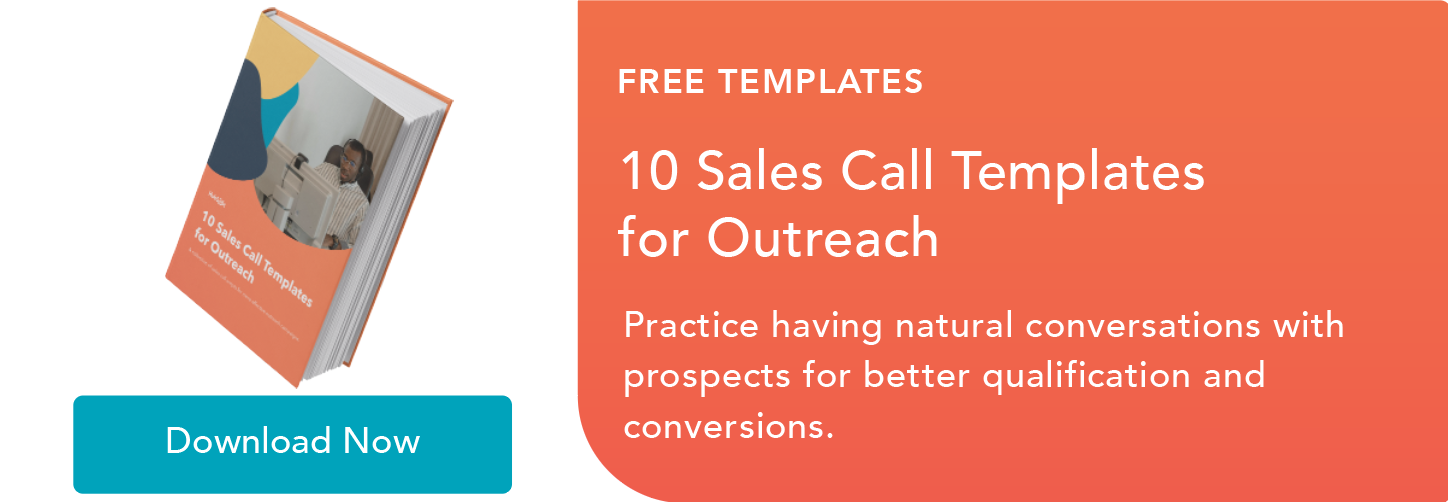For most sales reps, cold calling is about as fun as a root canal. In fact, it's one of the toughest games to crack.
Still, despite its flaws, it's one of the most effective ways to connect with prospects. But in order to see results, you need a solid strategy at play. Luckily, science can point us in the right direction.
Free Resource: 30 Sales Call Script Templates
[Download Now]
Here, we'll cover 19 science-backed tips to uplevel your cold calling strategy and make better calls.
19
- Start sales calls with a bang.
- Buy as much time as possible.
- Don't bad-mouth competitors.
- Use awesome labels.
- Set the agenda and stay in control.
- Stand up.
- Use emphasis wisely.
- Adopt a cold-calling persona.
- Simplify options.
- Adopt smart product positioning.
- Get emotional.
- Clarify product value.
- Empower customers.
- Use risk-reversal language.
- Remember, there's a time for everything.
- Serve hot, not cold.
- Observe, record, and predict.
- Make it about you, too.
- Avoid the traditional close.
1. Start all sales calls with a bang.
Always start your sales calls in style. One study tried to figure out how to increase room service tips for waiters in hotels. Much to the researchers' surprise, all the waiters had to do was start with a positive comment. When hotel guests opened their door, waiters said "good morning" and gave a positive weather forecast for the day.
How does this help you? Never start your sales calls or meetings by talking about bad weather, traffic, or being busy. Always begin with a positive comment or anecdote. Think great weather, fun weekend plans, or a favorite sports team winning a game. That kicks most sales calls off on the right foot.
2. Buy as much time as possible.
It's not enough to get a prospect's attention during a cold call — you also need to hold it. Research shows the longer the sales call, the greater your chance of securing a follow-up meeting or demo. In fact, successful cold calls — or ones that end in a follow-up meeting — typically last around five minutes.
Remember, the secret to cold calling isn't about talking — it's about listening. While your cold call likely begins as a pitch, it should slowly evolve into a back-and-forth conversation. Once a prospect starts talking, let them speak without interruption. If they speak for four minutes straight, the probability of winning the sale increases.

30 Free Sales Call Templates
Have better conversations with your sales prospects using these free templates.
- Discovery call template
- Follow-up call template
- Standard outreach template
- And more!
Download Free
All fields are required.

3. Don't bad-mouth competitors during sales calls.
The biggest self-sabotaging mistake during a sales call is to speak ill of a competitor. Due to a psychological quirk called "spontaneous trait transference," research has shown that whenever you say bad things about someone else, your audience puts those same traits on you.
For instance, if you say your competitor is unreliable, your potential client can’t help but associate this traits with you, even if they know logically that you are talking about a third party. So no matter what, when it comes to gossip about competitors, always say, "No comment."
4. Use awesome labels.
Assigning a positive label or trait to people — like having high intelligence or being a good person — generally compels them to live up to the label.
In one study about fundraising, researchers told average donors that they were, in fact, among the highest donors. Can you guess what happened? Those donors proceeded to donate an above average amount.
When you are with a client or potential customer, give them good labels. Of course, be sure that the labels are sensible and genuine. Never attempt anything that will push people into thinking that you are inauthentic, fake, or manipulative.
For example, you can say, "You are one of our best customers" or, "You’re such a pleasure to do business with." Having received the compliment, the client will want to be one of your best customers or try even harder to be a pleasing business partner.
5. Set the agenda and stay in control.
When I get on sales calls that I've set up from meeting requests, I always like to articulate clear agendas and ask the prospects if that's okay with them. This way, I can keep calls on track and accomplish what I want to achieve while making customers feel that they are in control of the conversation.
For example, you might say, "Well, I’m glad we can connect today. I’d love to go over XYZ and then answer any questions you might have. How does that sound to you?"
6. Stand up.
Allow your passion and excitement for the product to come through in your sales calls. Make it something the prospect can be infected by. In my experience, sales reps can achieve this by standing up and doing sales calls in a main common space instead of hiding in a cubicle or a conference room.
As former Mattermark CEO Danielle Morrill says, "Speak loud and proud!"
7. Use emphasis wisely.
Highlighting certain words or phrases is an effective communication tool that helps you convey your message better. Focus on your inflection, especially on voicemails. Former Bedrock Data CEO John Marcus describes this as "putting makeup" on your calls.
By adding inflection to the right words, you sound more passionate and articulate and, in turn, more convincing.
8. Adopt a cold-calling persona.
Often, it's not the cold-calling itself people are timid of — it's the fear of rejection and embarrassment. But the truth is, 60% of customers say no four times before saying yes. In other words, you have to persevere through a lot of rejection before you can land a sale.
To soften the blow, research suggests adopting a cold-calling persona. It's a way to separate yourself from the feeling of personal rejection. While this may not affect your close rate, it makes the rejection feel less brutal and puts you in a better, more productive headspace.
9. Simplify options.
Too many options can easily confuse buyers, making it harder for them to select, rationalize, and affirm a purchase decision. Unless you're a data analytics engine, information overload rarely delivers a benefit.
When describing your product, reduce the number of options and features you want the prospect to focus on. The goal is to show them just enough of your product to solve their problems without going overboard on details.
This way, they can arrive at a decision faster and feel more confident that they are not missing out on anything. Only when the likelihood of attrition/rejection becomes overwhelming should you present countermeasures (i.e., the next tier of options).
10. Adopt smart product positioning.
How you frame your product often spells the difference between a closed deal and a lost opportunity. Groundbreaking research in behavioral economics confirms that framing matters.
For example, saving $10 feels oddly different across varied buying scenarios (purchasing a smartphone vs. buying a shirt, for example) even when the amount saved is exactly the same.
Packaging the product as a solution instead of just a commodity or service also increases the likelihood of conversion. At the end of the day, you perform better by solving problems than by selling products.
11. Get emotional.
People rarely hinge their purchase decisions on solidly rational grounds. In most cases, they buy stuff largely because of emotional triggers and other hyper-personal, sometimes illogical factors.
Nostalgia, brand loyalty, associative/sentimental attachments to a product, and other intangible benefits can serve as persuasion levers as much as a product's technical features.
When engaging prospects, probe for the emotional button that can sway their purchase decision. Articulate a product'’s value through the use of relevant and powerful storytelling. In some instances, adopting the pleasure-pain dichotomy may work. Depending on the situation, people's aversion to pain or their deep anticipation of pleasure can be leveraged as powerful selling tools.
Lastly, personal trust — however misplaced — also works in selling, as social media recommendations prove. People will believe an idea or buy a product if these are endorsed by family, friends, or influencers they trust. As a seller, you can pull this powerful string through referrals, testimonials, and influencer marketing.
12. Clarify the product's value.
Make it easier for prospects to assess a product's subjective (emotion-based) and objective (fact-based) benefits. Use storytelling and framing techniques to set your product apart from other options available in the market.
Whenever possible, have an ROI calculator or formula at hand to help prospects quantify the benefits of the product when emotional triggers are inadequate to push them towards a firm decision. In either case, clearly demonstrate that the value customers receive more than justifies the price.

30 Free Sales Call Templates
Have better conversations with your sales prospects using these free templates.
- Discovery call template
- Follow-up call template
- Standard outreach template
- And more!
Download Free
All fields are required.

13. Empower customers.
People enjoy discovering stuff that makes them feel good or solutions that address their pesky problems. But they resent being forced, wrangled, goaded, or tricked into a purchase decision.
Because business is leaning more towards a subscription-based paradigm, brands aim to build long-term relationships with customers. If people perceive that you are force-feeding terms or tricking them into buying, you’ll lose not just customers but a revenue stream. Hence, give customers enough space, freedom, and power to make purchase decisions they will not regret.
You can achieve this by closely involving customers in developing the solutions they need. Get their feedback and give them a semblance of control in the problem-solving process. But always direct the conversation towards your value proposition.
14. Use risk-reversal language.
If you're like me, you always check the return policy before buying anything online. Why? Because every purchase — big or small — comes with a degree of risk. And it just so happens that people hate taking risks.
Odds are, your prospects are thinking, "Will this really solve my problems?" or, "Is it worth the price?"
If the perceived risk for your product is high enough, your cold call comes to a halt. But, you can remedy this by using risk-reversal language — phrases like, "no contracts," "easy opt outs," and "cancel anytime." In fact, 32% of sales reps saw an increase in win rates using phrases like these.
Taking on the risk gives prospects an easier path to convert. In other words, you make it easy for them to do business with you.
15. There's a time for everything.
In life as in sales, timing matters. Depending on your industry and the specific prospect you are engaging, the proper timing for making calls, doing presentations, sending emails, scheduling meetings, and attempting a close exist.
There are a number of studies that pinpoint the specific times within a day most optimal for reaching out to your target consumers. Find one for your niche and implement accordingly.
16. Serve hot, not cold
Practically speaking, cold calling is becoming a relic of the past. With business intelligence software, social media, and other digital resources, approaching a prospect without any clue about who they are and what they need has become a grossly desperate if not an outright stupid move to make.
Plan and prepare for each call. Use business intelligence tools, like RingCentral, Aircall, and Dialpad to unify all your communications in one place. Additionally, probe their social media accounts to discover pain points and other opportunities.
Participate in their conversations and identify the values, thought leaders, and brands they associate with. Know as much as you can about a prospect to make them feel important, that you have done your homework, and care about their success.
17. Observe, record, and predict.
Much of science involves carefully observing nature, recording your findings, and making predictions based on your observations. Sales follows a similar framework.
The key is to limit your talk time and listen to what your prospects are saying. When prospects talk extensively about their situation, you have already pulled the right strings. Keep them talking. Observe their behavior. Discern their needs based on their statements. Design and propose a solution that squarely addresses their problems.
Ask the right questions. Probe for relevant answers. And truly listen. That is what top-notch selling is all about.
18. Make it about you, too.
Selling is a two-way street. Even if you take care of customers but neglect honing your skills and attitude as a sales practitioner, you won’t go as high as you could.
Customers warm up to and trust business contacts who are masters at their craft. Train to be the very best at what you do so customers will see that your solutions are peerless, and they will lose significant value when they move to another vendor.
Think big and set higher goals to challenge yourself and your team. As behavioral economists suggest, organize your goals into several mini objectives that incrementally increase in difficulty. Perform the easy ones first to establish a string of successes that will give you the momentum, confidence, and motivation you need to beat more challenging goals later on.
19. Avoid the traditional close.
How you close a cold call is just as critical as how you start it. Generic phrases like, "Hope we can talk soon" or, "I'll circle back later" are safe options, but they rarely inspire action.
Before hanging up, try asking a question — something along the lines of, "Next time we talk, I want to show you [X]. How about next Wednesday?" This creates an easy path for the follow-up meeting.
Back To You
If cold-calling sends you into a cold sweat, you're not alone. In order to succeed, it's often about having the right strategies in place. Start with the tips in this post and continuously test different approaches to find what works best.
.png?width=112&height=112&name=Image%20Hackathon%20%E2%80%93%20Vertical%20(62).png)


![How to Build a Business Development Strategy: 8 Highly Effective Tactics [+ Template]](https://www.hubspot.com/hubfs/Copy%20of%20Featured%20Image%20Template%20Backgrounds-2.png)








